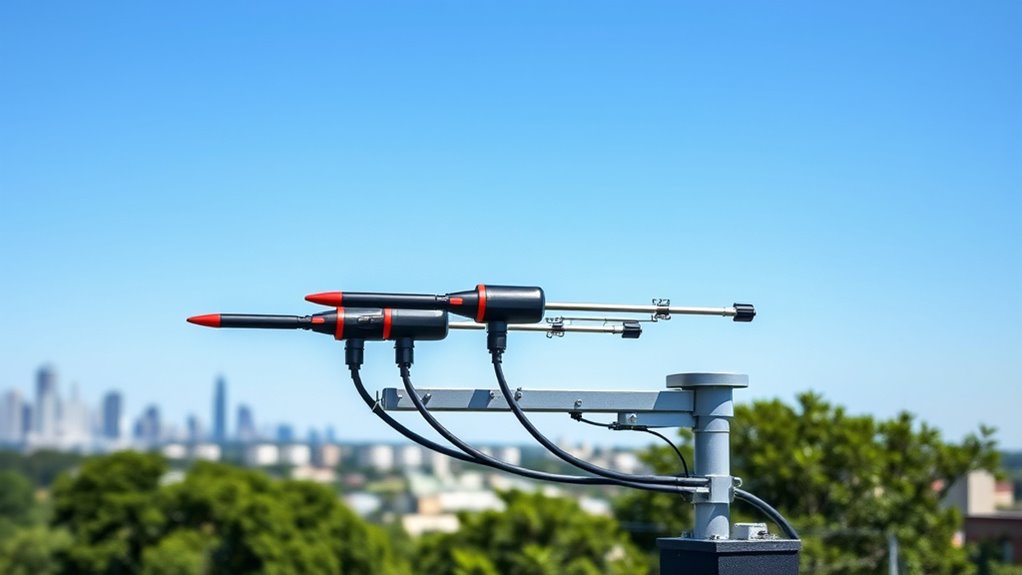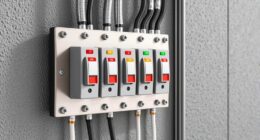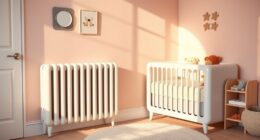If you’re looking for the best dual band antennas for your ham radio station in 2025, I recommend models that combine high durability, good gain, and easy installation. Fiberglass designs like the TWAYRDIO and Tram 1477 are great for outdoor setups, while compact options like the Diamond X30A suit indoor or attic spaces. Many support 100W-200W power and come pre-tuned for quick setup. Keep exploring to find the perfect match for your needs and setup.
Key Takeaways
- Top-rated dual band antennas with high gain, weather resistance, and durable construction suitable for various outdoor and indoor ham radio setups.
- Models offering easy installation, adjustable tuning, and versatile mounting options for stable long-term operation.
- Antennas supporting up to 200W power handling, optimized for base station use, repeaters, and long-distance communication.
- Popular choices include fiberglass, aluminum, and compact designs for space-constrained environments or attic mounting.
- The best antennas balance performance, durability, affordability, and ease of maintenance for ham radio enthusiasts in 2025.
Dual Band VHF UHF Antenna for Ham Radio Base Station
If you’re serious about setting up a reliable ham radio base station, a dual band VHF/UHF antenna is an excellent choice, especially because it allows you to operate on both 2-meter and 70-centimeter bands simultaneously. This antenna includes a 10-meter high-quality coaxial cable with versatile connectors, making installation straightforward. It’s designed for high power, with a 200-watt rating and impressive gain—4.5 dB on VHF and 7.2 dB on UHF—ensuring strong signals. Its rugged, waterproof construction and 66.9-inch height make it durable for various weather conditions, ideal for reliable, continuous operation at your station.
Best For: Amateur radio enthusiasts and operators seeking a durable, high-performance dual band antenna for reliable base station communication on VHF and UHF bands.
Pros:
- Supports simultaneous operation on 2-meter and 70-centimeter bands with high gain (4.5 dB VHF, 7.2 dB UHF).
- Includes a high-quality 10-meter coaxial cable with versatile connectors for easy installation.
- Rugged, waterproof design ensures durability and reliable performance in various weather conditions.
Cons:
- Height of 66.9 inches may require sufficient space for optimal installation.
- Max power rating of 200 Watts might limit use in extremely high-power applications.
- Requires an optional duplexer for simultaneous operation of both bands, adding extra cost and setup complexity.
TWAYRDIO Dual Band VHF UHF Fiberglass Base Antenna (144/430MHz)
The TWAYRDIO Dual Band VHF UHF Fiberglass Base Antenna is an excellent choice for ham radio enthusiasts seeking a reliable, all-in-one solution for 144 and 430 MHz bands. It features a 50-ohm impedance, 5.5/8.5 dBi gain, and a maximum input power of 200W, making it versatile for various setups. Its fiberglass construction guarantees durability outdoors, and it’s pre-tuned, so no extra tuning is needed. With a height of 86.6 inches and weather-resistant design, it supports pole diameters up to 2.4 inches. Users appreciate its solid build and decent reception, though some note UHF tuning can be a bit tricky.
Best For: ham radio enthusiasts looking for a durable, all-in-one dual-band fiberglass antenna suitable for outdoor VHF/UHF base station or repeater setups.
Pros:
- Constructed from heavy-duty fiberglass with weather-resistant features for outdoor durability
- Pre-tuned design requiring no additional tuning, simplifying installation
- Supports pole diameters up to 2.4 inches and offers solid reception and transmission performance
Cons:
- Some users report SWR around 3 on UHF bands, indicating potential tuning adjustments are necessary
- Limited tuning flexibility, especially on the UHF band, which may affect optimal performance
- Coax cable sold separately, adding to overall setup cost
Tram 1477 Dual-Band Base Antenna for VHF/UHF
For ham radio enthusiasts seeking a reliable, all-in-one antenna for both VHF and UHF bands, the Tram 1477 Dual-Band Base Antenna stands out with its pre-tuned design and excellent performance. It covers 144-148 MHz VHF and 430-460 MHz UHF, offering 3.5 dBd VHF and 6 dBd UHF gain. Its 43-inch white fiberglass construction makes it durable, weather-resistant, and easy to install. With low SWR readings, it guarantees efficient power transfer. The omnidirectional design provides 360-degree coverage, ideal for reliable signal reception over long distances. Overall, it’s a versatile, high-quality antenna suited for amateur radio, GMRS, and base station use.
Best For: ham radio enthusiasts and operators seeking a durable, versatile, dual-band antenna for reliable VHF and UHF communication.
Pros:
- Pre-tuned for optimal performance across VHF and UHF bands, ensuring ease of setup.
- Durable white fiberglass construction withstands harsh weather conditions.
- Omnidirectional design provides 360-degree coverage for reliable signal reception over long distances.
Cons:
- Slightly higher SWR on some middle frequencies, especially on MURS, which may require tuning adjustments.
- Requires mounting hardware and coax cables sold separately, adding to initial setup costs.
- May be less effective in very dense urban environments due to outdoor-oriented design.
Diamond Antenna X30A Dual-Band Base/Repeater Antenna
Designed specifically for ham radio enthusiasts with limited space, the Diamond Antenna X30A offers a compact yet powerful solution for dual-band operation. Its 4.5-foot fiberglass radome, stainless steel hardware, and UHF connector make it durable and suitable for indoor or confined outdoor spaces. Factory pre-tuned means no extra tuning needed, and it handles up to 150W, making it versatile for various setups. Users praise its solid construction, ease of installation, and reliable performance on 2M and 70cm bands. Whether for HOA restrictions, attic use, or portable setups, the X30A delivers strong signals and durability in a compact form.
Best For: ham radio enthusiasts with limited space, HOA restrictions, or those seeking portable, indoor, or attic installation solutions for dual-band operation.
Pros:
- Compact and lightweight design, easy to install in confined spaces or indoors
- Factory pre-tuned with no additional tuning required, saving setup time
- Durable construction with fiberglass radome and stainless steel hardware, supporting up to 150W
Cons:
- Limited height and size may reduce maximum range compared to larger outdoor antennas
- SWR values can vary depending on installation and location, requiring some user adjustment
- Not suitable for very high-power applications beyond 150W or extremely long-distance communication
Dual Band Antenna for Ham Radio (144MHz/433MHz, 100W)
If you’re looking for a reliable dual-band antenna that handles up to 100W and offers straightforward installation, this model is an excellent choice for ham radio enthusiasts. It covers 144MHz (VHF) and 433MHz (UHF), with pre-tuned frequency ranges of 136-174MHz and 400-470MHz, so no additional tuning is needed. The antenna provides solid gain—3.5dBi at 144MHz and 5.5dBi at 433MHz—along with a VSWR of ≤1.5 for efficient signal transmission. Constructed from waterproof, corrosion-resistant materials, it’s designed for outdoor use, mounting easily on poles 40-60mm in diameter. Its white fiberglass radome and stainless steel radials ensure durability and performance.
Best For: ham radio enthusiasts seeking a durable, easy-to-install dual-band antenna capable of handling up to 100W for outdoor and mobile communication use.
Pros:
- Pre-tuned for quick installation without additional tuning required
- Waterproof and corrosion-resistant construction suitable for outdoor environments
- High gain of 3.5dBi at 144MHz and 5.5dBi at 433MHz with excellent VSWR performance (≤1.5)
Cons:
- Some users report high SWR and signal issues on the VHF band (144MHz)
- Limited vertical beam width (33° at 144MHz, 17° at 433MHz), which may require precise positioning
- Slightly heavier and larger compared to compact antennas, which might affect portability
Tram Dual-Band UHF/VHF Base Antenna (1477-B)
The Tram 1477-B dual-band UHF/VHF base antenna stands out as an excellent choice for amateur radio operators seeking reliable, high-gain performance without complex tuning. Its black fiberglass construction is durable and discreet, standing 43 inches tall and weighing just over 2 pounds. Designed to be pre-tuned, it covers 144–148 MHz VHF and 430–460 MHz UHF bands with gains of 3.5 dBd and 6 dBd, respectively. Many users report excellent SWR values below 1.7:1, with some as low as 1.02:1. Easy to install on various supports, it’s ideal for both beginners and experienced operators wanting robust, wide-band coverage.
Best For: amateur radio operators and GMRS users seeking a durable, wide-band, high-gain antenna suitable for varied installation environments, including restricted or discreet settings.
Pros:
- Rugged fiberglass construction with high durability and low visibility
- Wide bandwidth with excellent SWR typically under 1.7:1, ensuring reliable performance
- High gain of 3.5 dBd on VHF and 6 dBd on UHF for extended range and clear signal reception
Cons:
- Hardware is metric, which may require adaptation or modification for some mounts
- Slight resonance off-center can cause higher SWR near band edges, possibly needing tuning
- Lack of detailed assembly instructions or diagrams may challenge beginners during setup
TW-8300 Car Ham Antenna CB HF 3.5-30MHz Portable Telescopic
For ham radio enthusiasts looking for a portable yet dependable antenna, the TW-8300 Car Ham Antenna stands out with its telescopic design and wide frequency range of 3.5 to 30 MHz. It’s lightweight at just over a pound and extends up to 8.5 feet, making it easy to deploy in the field. Built with solid construction, it’s suitable for temporary setups, especially when tuning for ideal SWR with an external tuner and ground plane. Its adjustable coil and plastic calibration marks facilitate quick tuning. Highly rated by users, it performs well on digital modes like FT8, provided you handle it carefully and guarantee proper grounding.
Best For: ham radio operators seeking a portable, easy-to-tune antenna for field operations and digital mode communications across 3.5 to 30 MHz bands.
Pros:
- Lightweight and extendable up to 8.5 feet for easy deployment in the field
- Solid construction suitable for temporary portable setups
- Adjustable coil and calibration marks facilitate quick and effective tuning
Cons:
- Not wind or rainproof, requiring careful handling in adverse weather
- Requires a proper ground plane and external tuner for optimal performance
- Telescoping sections may need careful handling to prevent damage
Retevis 144/430MHz Dual-Band Base Antenna (1 Pack)
Designed with VHF and UHF amateur radio operators in mind, the Retevis 144/430MHz Dual-Band Base Antenna offers high gain and wide bandwidth to guarantee clear, stable communication. It features a real 7.2 dBi gain, low SWR, and a durable construction with alloy components that resist wind and thunderstorms. Its lightweight, three sub-antenna design makes installation easier, especially on 12-foot masts. While it performs well on the 2-meter band, users report mixed results on UHF, with higher SWRs affecting performance. Overall, it’s a solid choice for VHF use, with good build quality and user-friendly assembly, but UHF performance may require adjustments.
Best For: amateur radio enthusiasts seeking a durable dual-band base antenna with strong VHF performance and manageable installation for remote or high-mast setups.
Pros:
- High gain of 7.2 dBi provides excellent VHF signal strength and clarity.
- Durable construction with alloy components resistant to wind and thunderstorms.
- Lightweight, three sub-antenna design simplifies installation on 12-foot masts.
Cons:
- Mixed UHF performance with high SWR, requiring adjustments for optimal operation.
- UHF SWR often remains above recommended levels, affecting transmission quality.
- The antenna-to-mast clamp made of soft aluminum may raise concerns about long-term wind durability.
Dual Band VHF UHF Antenna for Ham Radio Repeater Station
If you’re setting up a ham radio repeater station, a dual band VHF UHF antenna offers the reliable, high-power performance needed to guarantee strong signals on both bands simultaneously. This antenna features a 66.9-inch height, making it ideal for robust reception and transmission. It operates on 144 MHz and 440 MHz bands with a maximum power rating of 200 watts, ensuring excellent coverage. The included 10-meter LMR240 coaxial cable and versatile connectors (UHF, SMA, BNC) make installation straightforward. Its rugged, waterproof design guarantees durability in various weather conditions. Perfect for base stations, this dual band antenna delivers consistent, high-quality performance for repeater applications.
Best For: Ham radio enthusiasts and professionals setting up reliable, high-power repeater stations on VHF and UHF bands.
Pros:
- Dual band operation allows simultaneous use of 144 MHz and 440 MHz bands for versatile communication.
- High power capacity of 200 Watts ensures strong signal transmission and reception.
- Rugged waterproof design enhances durability in various weather conditions.
Cons:
- Requires an optional antenna duplexer for simultaneous operation of both bands, adding to setup complexity.
- Height of 66.9 inches may require additional mounting considerations in some locations.
- Installation and tuning may require some technical knowledge for optimal performance.
HYS Dual-Band VHF/UHF Magnet Base Antenna for Radio Repeater with Magnetic Mount
The HYS Dual-Band VHF/UHF Magnet Base Antenna stands out as an excellent choice for ham radio enthusiasts seeking a reliable, easy-to-install solution for radio repeaters and mobile radios. It covers 144MHz and 430MHz bands, supporting brands like Motorola, Kenwood, Icom, and Baofeng. With a stainless steel build, it’s durable and efficient, offering 2.15dBi gain at VHF and 3.5dBi at UHF. Its magnetic base allows quick mounting on metal surfaces, making it versatile for indoor or outdoor use. The included 13-foot RG58 cable ensures solid signal transmission, making this antenna a dependable, cost-effective upgrade for any ham radio setup.
Best For: ham radio enthusiasts and mobile radio users seeking a durable, easy-to-install dual-band antenna for indoor or outdoor use.
Pros:
- Supports multiple popular radio brands including Motorola, Kenwood, and Baofeng.
- Easy plug-and-play setup with magnetic mount for versatile placement.
- Made of stainless steel, offering durability and reliable performance.
Cons:
- Requires a metal ground plane for optimal magnetic base performance.
- Limited to 50W maximum power input, which may not suit high-power applications.
- Length of 43.5cm might be less suitable for users needing higher gain or more extended range.
TWAYRDIO Yagi Ham Radio Antenna, Dual Band 2m 70cm VHF UHF
For ham radio enthusiasts seeking reliable dual-band performance, the TWAYRDIO Yagi Ham Radio Antenna stands out with its high gain and straightforward construction. It features 8 elements and offers 9.5/11.5dBi gain for 2m and 70cm bands, handling up to 100W power with a VSWR below 1.5. Made from durable aluminum alloy, it’s weather resistant and easy to assemble, with a three-section boom and simple tuning process. Its directional design boosts signal strength and reduces interference, making it ideal for long-distance communication, satellite work, and repeater links. Weighing just 0.75kg, it’s lightweight yet rugged enough for outdoor use.
Best For: ham radio enthusiasts and operators seeking a durable, high-gain dual-band Yagi antenna for long-distance communication and satellite work.
Pros:
- High gain (9.5/11.5dBi) for improved signal strength and clarity
- Durable aluminum alloy construction with weather resistance
- Easy to assemble and tune, suitable for outdoor use
Cons:
- Manual may lack detailed tuning instructions, requiring user experience
- Some units may arrive with assembly scratches or loose screws due to used or returned condition
- Tuning adjustments need in-situ effort and appropriate tools, which may be challenging for beginners
TW-8300 Car Ham Antenna (7350) CB HF Mobile Radio Antenna, Telescopic, 3.5-30MHz/50MHz
Designed for mobile operation, the TW-8300 (7350) Car Ham Antenna offers a versatile telescopic design that extends up to 2.6 meters, making it ideal for ham radio enthusiasts seeking effective communication on HF and CB bands. Its lightweight construction, weighing just 490 grams, and compact size make it easy to install and transport. The antenna supports frequencies from 3.5 to 50 MHz, covering essential HF bands with a 130W power rating. Equipped with a UHF Male (PL-259) connector, it provides reliable transmission and reception, making it a practical choice for mobile and portable radio setups in various vehicles.
Best For: ham radio enthusiasts and mobile users seeking a versatile, portable antenna for effective HF and CB communication in various vehicle setups.
Pros:
- Telescopic design allows extended length up to 2.6 meters for better signal reach
- Lightweight and compact at only 490 grams, facilitating easy transport and installation
- Supports a wide frequency range from 3.5MHz to 50MHz with a high 130W power rating
Cons:
- May require additional mounting hardware for secure installation in some vehicles
- Reduced 1/4 wave design might limit performance compared to full-length antennas in certain conditions
- Compatibility limited to UHF Male (PL-259) connectors, potentially requiring adapters for some setups
UV100 Dual Band Base Antenna for Ham Radio Station
If you’re looking for an affordable, reliable antenna for your ham radio base station, the UV100 Dual Band Antenna is a solid option. It measures 41 inches and supports 144/430MHz bands, with a VHF gain of 3.5dB and UHF gain of 7dB, boosting communication range. Made from durable fiberglass, it’s built to withstand tough conditions and features a ground plane design for low-angle, omnidirectional radiation. Easy to install with all mounting accessories included, it offers stable signal quality with a VSWR under 1.5 across both bands. While not top-tier, it’s a budget-friendly choice for everyday use and general reception.
Best For: budget-conscious ham radio enthusiasts seeking a durable, easy-to-install antenna for general communication and reception.
Pros:
- Solid fiberglass construction ensures durability and resistance to harsh environments
- Supports 144/430MHz bands with stable VSWR below 1.5 for reliable signal quality
- Easy to assemble and includes all mounting accessories, making installation straightforward
Cons:
- Limited transmitting performance with higher SWR at certain frequencies
- Some users report issues with loose screws, missing components, or defective parts
- Not suitable for high-end or professional-grade communication needs
Dualband Antenna for VHF/UHF Ham Radio (137-149 & 437-480 MHz) with Magnet Base and 10 ft RG58 Cable
This dual-band antenna is an excellent choice for ham radio enthusiasts seeking reliable, portable communication on VHF and UHF bands, especially when mounted on a vehicle. Its omni-directional, quarter-wave design provides strong signal gain (2dBi/3dBi) with a low SWR (less than 1.4 at 145 MHz and less than 1.2 at 455 MHz). The waterproof stainless steel construction, heavy-duty 10-foot RG58 cable, and powerful magnetic base ensure durability and stability at high speeds. Easy to install and remove, it offers effective coverage over 40 miles, making it ideal for mobile, emergency, or recreational use.
Best For: ham radio enthusiasts, emergency responders, and vehicle operators seeking a reliable, portable dual-band antenna for VHF and UHF communication.
Pros:
- High signal gain with low SWR, ensuring clear communication
- Durable waterproof stainless steel construction with anti-rust magnetic base for long-term use
- Easy installation and removal with a strong magnet, suitable for mobile and portable setups
Cons:
- Limited cable length may require extension for larger vehicles or specific mounting positions
- Not a permanent fixture; designed as a portable solution rather than a fixed antenna
- Shorter length compared to 5/8 wave antennas might reduce some gain in certain scenarios
Dual Band Fiberglass Radio Antenna with Mount Bracket
The Dual Band Fiberglass Radio Antenna with Mount Bracket stands out as an excellent choice for ham radio enthusiasts seeking a durable, weatherproof antenna that can be installed indoors or outdoors without the need for a ground plane. Measuring 17 inches and made from UV-resistant fiberglass, it supports VHF (136-174MHz) and UHF (400-470MHz) frequencies with a 2.5dBi gain, handling up to 100W. Easy to mount on rooftops, walls, or inside, it offers stable signals and simple setup. While some users experience tuning issues, many appreciate its lightweight design, corrosion resistance, and versatility for base stations, repeaters, or portable use.
Best For: ham radio operators, emergency communicators, and outdoor enthusiasts seeking a durable, easy-to-install dual-band antenna without ground plane requirements.
Pros:
- Durable fiberglass construction with weatherproof and UV-resistant features
- Easy to install indoors or outdoors without needing a ground plane
- Supports multiple applications including base stations, repeaters, and portable setups
Cons:
- May require tuning adjustments to achieve optimal SWR on ham bands
- Some users report limited coverage and high SWR if not properly installed
- Performance can vary depending on coax quality and ground plane configurations
Factors to Consider When Choosing Dual Band Base Antennas for Ham Radio

When choosing a dual band base antenna, I focus on key factors like frequency compatibility to make sure it covers my desired bands, and power handling capacity to match my transmitter’s output. I also consider how durable the antenna is for long-term use and how easy it is to install in my setup. Finally, size and height matter because they affect performance and space requirements.
Frequency Compatibility
Are you confident that your dual band base antenna covers all the frequencies you plan to operate? It’s vital to verify the antenna’s frequency range aligns with your target bands, like 144-148 MHz for 2 meters and 430-470 MHz for 70 centimeters. Make sure it’s pre-tuned for these bands to minimize adjustments. Check the VSWR specifications across both VHF and UHF bands to guarantee efficient power transfer and prevent damage. Compatibility with your radio’s connector type, whether UHF (SO-239) or BNC, is essential for a secure connection. If you need to operate both bands simultaneously, confirm the antenna supports dual-band operation without compromising performance. Proper frequency compatibility ensures reliable communication and ideal antenna performance.
Power Handling Capacity
Choosing a dual band base antenna requires paying close attention to its power handling capacity, as this determines how much wattage it can safely transmit without getting damaged. Most antennas handle between 100W and 200W, but exceeding this rating can cause overheating, component failure, or shorten the antenna’s lifespan. It’s essential to match the antenna’s maximum power rating with your transmitter’s output power to guarantee reliable operation. Higher power capacity often results in better performance, especially for high-power applications like repeater stations or base stations transmitting at 100W or more. Always consider both the antenna’s power rating and your radio’s output to prevent damage and maintain ideal signal quality. Proper matching helps protect your equipment and ensures consistent, clear communication.
Antenna Durability
Durability is a crucial factor when selecting dual band base antennas, especially since they often face harsh outdoor conditions. I look for antennas made from high-quality materials like fiberglass, stainless steel, or those with corrosion-resistant coatings, as these resist weather damage and last longer. Reinforced construction, weatherproof seals, and sturdy mounting hardware are essential to prevent water ingress, corrosion, and physical wear. I also check wind ratings; antennas tested to withstand wind speeds of 60-85 mph or more are better suited for windy environments. Regular maintenance, including inspecting fittings and looking for corrosion, helps preserve performance and extend the antenna’s lifespan. Choosing a sturdy antenna ensures reliable operation regardless of the weather, saving me time and money in the long run.
Installation Ease
When selecting a dual band base antenna, considering installation ease can save you a lot of time and frustration. I look for antennas with straightforward mounting hardware and clear instructions to simplify setup. Having thorough accessories like brackets and clamps helps me quickly attach the antenna to different support structures. I also prefer models that are pre-tuned or factory-adjusted, so I don’t spend extra time tuning in the field. The weight and size matter too—lighter, compact antennas are easier to handle and install without special tools. Features like versatile mounting options—pole, wall, or tripod—and simple connection types such as BNC, SMA, or UHF make the process smoother. Prioritizing these factors ensures a hassle-free installation, saving effort and reducing the risk of errors.
Size and Height
How does the size and height of a dual band base antenna influence your signal coverage? Taller antennas generally provide better gain and broader reach because they can transmit signals over a larger area. Antennas around 5 to 7 feet are common for base stations, offering a good balance between performance and manageable size. Longer antennas tend to improve signal strength on both 2m and 70cm bands, helping you communicate over longer distances. However, the physical dimensions must fit your installation environment, whether it’s indoors, on a rooftop, or in a limited outdoor space. Adjustable or foldable antennas give you flexibility, letting you modify height for ideal performance or space constraints. Overall, choosing the right size and height is key to maximizing your antenna’s effectiveness.
Gain and Radiation
Choosing the right dual-band base antenna involves understanding its gain and radiation pattern, as these factors directly impact your signal strength and coverage. Higher gain antennas, typically between 2 and 11 dBi, provide stronger signals and longer communication distances, which is essential for reliable contact. The radiation pattern determines how the signal propagates—whether it’s omnidirectional for broad coverage or directional for focused reach. Dual-band antennas often balance gain across VHF and UHF, but performance can vary depending on design and tuning. Additionally, higher radiation efficiency means more of your power is effectively radiated, enhancing overall performance. The antenna’s design, including element length and configuration, influences these factors, shaping how well it concentrates or disperses radio energy for ideal communication.
Weather Resistance
Selecting a weather-resistant dual band base antenna is essential for reliable operation outdoors, as it must endure various environmental challenges. I look for antennas built from durable materials like fiberglass, stainless steel, or corrosion-resistant alloys to withstand exposure to wind, rain, and snow. Proper waterproof sealing and gaskets are critical to prevent moisture from entering and damaging internal components. UV-resistant coatings help protect the antenna’s surface from sun deterioration over time. A high wind rating—often over 60 mph—is necessary to ensure stability during storms. Regular maintenance, such as checking for corrosion, loose fittings, and water damage, extends the antenna’s lifespan and guarantees consistent performance. Prioritizing weather resistance means my antenna stays functional and reliable regardless of outdoor conditions.
Price and Budget
Price is a key factor when I evaluate dual band base antennas for my ham radio setup, as it directly impacts my overall budget and the features I receive. These antennas typically range from about $30 to over $150, depending on their features, construction quality, and brand reputation. Budget options may have higher SWR or use less durable materials, which could affect long-term performance. Investing a bit more often yields better gain, lower SWR, and improved weather resistance, offering better value over time. Additionally, prices can vary based on included accessories like coaxial cables, mounting hardware, or pre-tuning. Comparing prices across vendors and reading customer reviews helps me find quality options that fit my budget while meeting my needs.
Frequently Asked Questions
What Is the Optimal Height for Installing a Dual Band Base Antenna?
The ideal height for installing a dual band base antenna is typically at least 20 to 30 feet above ground. I’ve found that higher installations, ideally around 40 to 50 feet, markedly improve signal strength and clarity. Keep in mind, local regulations and property restrictions might limit your height. I recommend choosing a sturdy, elevated spot to maximize performance without compromising safety or compliance.
How Does Antenna Gain Affect Transmission Range and Signal Quality?
Imagine I’m back in the days of Morse code, and antenna gain really is like a superhero power. Higher gain boosts your transmission range and sharpens signal quality because it focuses energy in a specific direction. This means I can reach farther and communicate clearer with less interference. So, the more gain my antenna has, the better my signal will perform, making my ham radio experience more reliable and enjoyable.
Are There Specific Weather Conditions That Impact Antenna Performance?
Yes, weather can definitely impact antenna performance. Rain, snow, and ice can cause signal attenuation or physical damage, reducing transmission quality. High winds might sway or damage antennas, affecting signal stability. Temperature fluctuations can also alter antenna properties slightly, impacting performance. I always recommend monitoring weather conditions and securing antennas properly, especially during storms, to maintain ideal signal quality and prevent damage.
What Maintenance Is Required to Ensure Long-Term Antenna Durability?
Think of your antenna as a garden needing regular tending. I check for corrosion, tighten connections, and inspect for wear at least once a year. I also clean the elements gently and guarantee the mounting is secure. When storms pass, I give it a quick visual. Consistent maintenance keeps my antenna singing strong across the airwaves, weathering time and elements like a steadfast lighthouse guiding ships home.
Can a Dual Band Antenna Be Used for Both Transmitting and Receiving Simultaneously?
Yes, a dual band antenna can be used for both transmitting and receiving simultaneously. I’ve found that most modern dual band antennas are designed with a shared feed point, allowing them to handle both functions at once without issues. This makes them ideal for ham radio enthusiasts like me who want seamless operation on multiple bands. Just make sure your radio and antenna are properly matched to avoid signal interference or damage.
Conclusion
Choosing the right dual band base antenna can truly transform your ham radio experience. I know it might seem overwhelming with so many options out there, but imagine finally reaching that distant station clearly, with your antenna standing tall and reliable. When you pick the right one, it’s like giving your station a powerful voice — reliable, strong, and ready to connect you to the world. Don’t let hesitation hold you back from better communication.





















